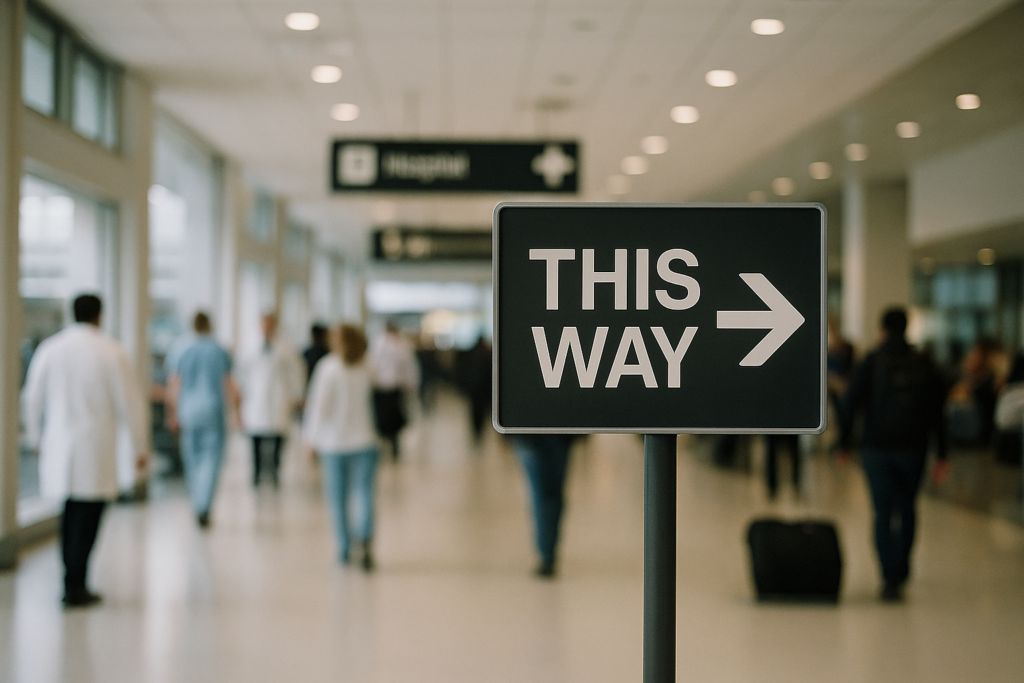In large venues such as hospitals, business parks, airports, or shopping centres, one common frustration unites visitors: difficulty finding their way. Traditional static signage often isn’t enough in large venues, especially in overwhelming environments where visitor expectations are higher than ever. This is where digital wayfinding truly elevates this once stressful process.
Modern digital wayfinding solutions combine dynamic displays, interactive maps, and real-time information to guide people efficiently from point A to point B. But the benefits go far beyond just navigation. Let’s explore why digital wayfinding is essential for large, modern venues.
Importance of Wayfinding Solutions
At its core, digital wayfinding is about improving accessibility and reducing confusion. But for large venues, the stakes are higher than just user satisfaction. Poor wayfinding in venues can lead to:
- Missed appointments or flights
- Increased stress for visitors and staff
- Congestion in busy areas
- Reduced overall efficiency
Effective digital wayfinding solutions offer a scalable, easily updatable system that reflects real-time changes, such as temporary closures or event-specific routes. For organisations, this means fewer repeated questions, less printed signage, and better use of space. Most importantly, it means a smoother, more confident journey for visitors.

Designing Effective Digital Maps
Digital maps can vary significantly in their quality and features. A well-designed system needs to be intuitive, responsive, and tailored to the environment it serves. Key features of effective digital wayfinding include:
- Interactive touchscreens that let users search by room, person, or service.
- Mobile compatibility so users can continue navigation on their phones.
- Real-time updates for temporary closures or emergencies.
- Multi-language support for diverse audiences.
- Accessibility features such as audio prompts and high-contrast modes.
Design should prioritise simplicity and clarity. Visual hierarchy, clear icons, and consistent colour coding help to reduce guests’ feelings of being overwhelmed and guide users naturally. A poorly designed, unclear map can be just as frustrating as no map at all, so user testing and iteration are crucial.
Enhancing Visitor Experience
Investing in digital wayfinding solutions is also a strategic move to improve the overall visitor experience. Here’s how:
- Reduced stress: Visitors don’t need to rely on asking for help or interpreting outdated signage.
- Increased confidence: Interactive systems put control in users’ hands, helping them feel more self-sufficient.
- Shorter wait times: Less time spent navigating means more time engaging with the venue’s services.
- Stronger brand impression: Clean, modern signage reflects an organisation that’s invested in user experience and technology.
In essence, digital wayfinding helps to reduce barriers. When people can move freely and confidently through a space, they engage with the environment and what it offers more positively, whether it’s medical care, retail, education, or entertainment.
Implementing in Various Sectors
One of the most powerful things about digital wayfinding is its ability to benefit more than one type of industry and environment. It’s a flexible solution that adapts to the needs of different sectors. Below are three examples where it’s making a measurable impact:
Sector #1: Healthcare
Hospitals are often large, complex, and high-pressure environments. Digital wayfinding solutions help patients and visitors find departments, wards, and services quickly, reducing anxiety and improving the overall flow. Some systems even integrate appointment check-ins and queue management to make things more streamlined. Hospitals should always be looking to advance their digital presence to improve patient experience.
For staff, this means fewer interruptions from lost visitors, allowing them to focus on patient care. For healthcare providers, it reflects a commitment to accessibility and patient experience.
Sector #2: Education
University campuses are often spread across multiple buildings and even different parts of a city. For new students and visitors, finding lecture halls, departments, or event spaces can be incredibly overwhelming.
Digital wayfinding kiosks placed at key entrances, paired with QR codes for mobile directions, can transform orientation and open-day experiences. With custom maps and route planning, schools can highlight accessibility routes, drop-off points, or event-specific directions, giving an impressive first impression to prospective students.
Sector #3: Transportation Hubs
Airports, train stations, and bus terminals thrive on efficiency. Delays caused by lost passengers can impact schedules and operations. Here, digital wayfinding provides real-time gate information, boarding updates, and multilingual navigation, all in one place.
Digital displays can be synced with transport systems to show live updates, helping passengers make informed decisions quickly. They also enable airports to update messaging quickly during disruptions or high-traffic periods, offering flexibility that printed signage can’t match.
Final Thoughts
As venues grow and user expectations shift, static signage simply can’t keep up. Digital wayfinding solutions offer a significantly smarter, more adaptable alternative that meets the demands of modern navigation and improves both efficiency and experience.
Whether you’re managing a hospital, running a university campus, or operating a transit hub, now is the time to consider how digital wayfinding can transform your space. Clear, accessible navigation is a must for creating spaces where people feel supported, informed, and at ease.
Contact TrouDigital to start your digital wayfinding project.
